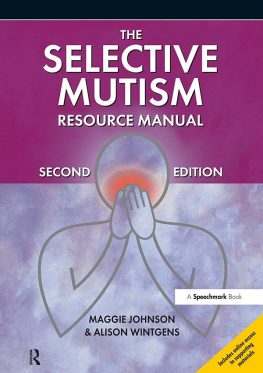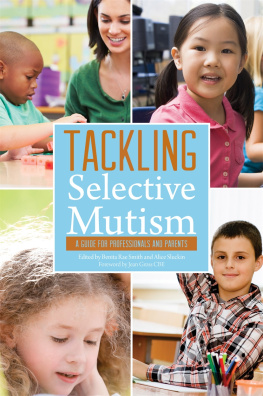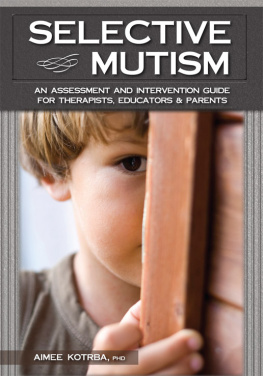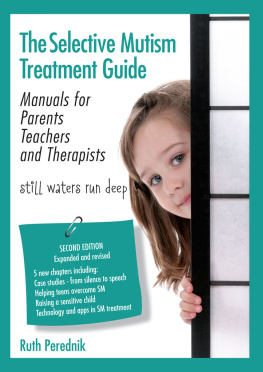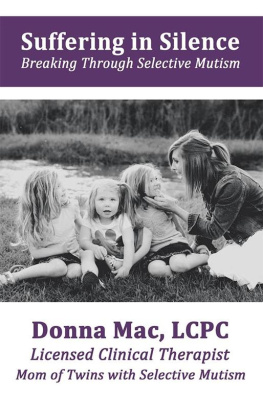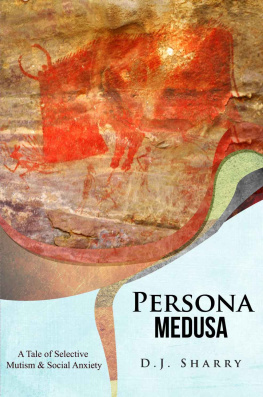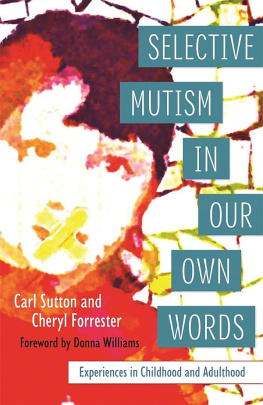The Selective Mutism Resource Manual Access your online resources
The Selective Mutism Resource Manual is accompanied by a number of printable online materials, designed to ensure this resource best supports your needs.
Activate your accompanying online resources:
- Go to www.routledge.com/cw/speechmark then click on the cover of this book
- Click the Sign in or Request Access button and follow the instructions, in order to access your accompanying online resources
The Selective Mutism Resource Manual
Second Edition
Maggie Johnson and Alison Wintgens
Courage is resistance to fear, mastery of fear not absence of fear.
Mark Twain (18351910)
Notes on the text
- Please note that, throughout this manual, the abbreviation SM is used to refer to selective mutism.
- We often specify which age group we are talking about (early years, younger children, adolescents or teenagers) but child or children is used where it is intended to be fairly general.
- Parent refers to parent or guardian.
- Practitioner refers to any therapist, psychologist or clinician working with the child and their family.
Dedications
To my Little Wurrit, who turned out to be the bravest of us all.
To Peter for his support, encouragement and patience.
First published in 2016 by Speechmark Publishing Ltd
Published 2017 by Routledge
2 Park Square, Milton Park, Abingdon, Oxon OX14 4RN
711 Third Avenue, New York, NY 10017, USA
Routledge is an imprint of the Taylor & Francis Group, an informa business
Copyright Maggie Johnson & Alison Wintgens, 2016
All rights reserved. The purchase of this copyright material confers the right on the purchasing institution to photocopy pages which bear the Photocopy icon and copyright line at the bottom of the page. No other parts of this book may be reprinted or reproduced or utilised in any form or by any electronic, mechanical, or other means, now known or hereafter invented, including photocopying and recording, or in any information storage or retrieval system, without permission in writing from the publishers.
Notice:
Product or corporate names may be trademarks or registered trademarks, and are used only for identification and explanation without intent to infringe.
British Library Cataloguing in Publication Data
A catalogue record for this book is available from the British Library
ISBN 978 1 90930 133 7 (pbk)
Contents
Guide
Twenty years ago, I met the first child with selective mutism (SM) in my clinical practice. I still remember the unpleasant feeling of incompetence and the literature gave few answers. This triggered me to start researching SM for the next two decades.
In 2016, the literature and knowledge about SM have improved considerably, and there is greater agreement among clinicians on how to understand and treat the condition. Maybe the most important progress has been to categorise SM as an anxiety disorder. Nevertheless, it is still a challenge to offer adequate help for these children.
This excellent resource manual presents updated information on important aspects of SM and above all practical and detailed information on how to deal with the problem that is relevant for clinicians, teachers, children and adolescents with SM and their family members. It also provides lots of useful handouts. The case stories are representative, illustrate the variation of symptoms in SM and emphasise the importance of tailoring interventions for each child.
The two authors have an extensive and unique experience with children and adolescents who have SM, and their deep respect for each individual is reflected in all of the chapters. They also address muteness in all relevant arenas and the impact on important people in each childs life. This is essential for treatment success and is a clear message to our colleagues not to restrict their intervention to clinical settings.
This book contains a wealth of knowledge!
Hanne Kristensen, MD, PhD
Centre for Child and Adolescent Mental Health
Southern and Eastern Norway
(March 2016)
Despite more parent organisations, training, books, research and media coverage in the last 15 years, selective mutism (SM) continues to be a misunderstood condition. However, its importance is as great as ever for several reasons. Children who have SM are at a significant disadvantage both personally and socially. SM is a great barrier to learning and, if neglected or mismanaged, it may continue into adulthood with devastating effects. Yet SM is hidden and easily overlooked the quiet child is the forgotten child and more attention and resources are directed towards children who are disruptive. Different disciplines may not agree on who should take responsibility for it; and many professionals do not have adequate training or see enough children who have SM to build up much experience.
SM has a significant and powerful effect on other people around the child, especially parents and teachers. The very nature of SM disrupts the normal process of interaction; and it is unnerving and even threatening when attempts to draw out a child are apparently rejected. It is our experience that people encountering SM for the first time rarely have sufficient information to feel confident about how to manage the child or put a treatment programme into practice, even when they are familiar with the principles involved. Furthermore, parents and professionals are sometimes afraid to intervene, in case they make the situation worse.
The earlier the situation can be addressed, the better for everyone involved.
When we met, both speaking about SM at an international conference in York in 1999, we decided to pool our experiences and perspectives as two speech and language therapists working in two different services: child and adolescent mental health and community health. We wanted to set out practical assessment and treatment, advice and information on how to identify and manage SM that was accessible for parents and a range of professionals. The result was the first edition of The Selective Mutism Resource Manual , published in 2001. Now, 15 years later, we have a total of over 60 years of working alongside several hundred children and young people with SM, directly and through supervision, acting as advisers, running parent groups, and teaching both in the UK and overseas.
Our ideas have inevitably developed but our approach has not changed fundamentally. This second edition of the manual is again based on the importance of having a good understanding of the nature of SM to create the right environment to manage it wisely; and the behavioural principles for building graded exposure programmes within a broader model of confident talking.
turn to adults who still have SM.
Please dont be put off by the size of this manual you dont have to read it all! It remains a resource manual, written for a wide range of people, including teachers, clinical and educational psychologists, speech and language therapists, child psychiatrists and importantly parents, and young people and adults who have SM. It contains a lot of material which on assessment. The parental interview forms are more suitable for clinicians, whereas the advice in Ensuring an anxiety-free environment and Facing fears at home and in the community has a much wider application.

